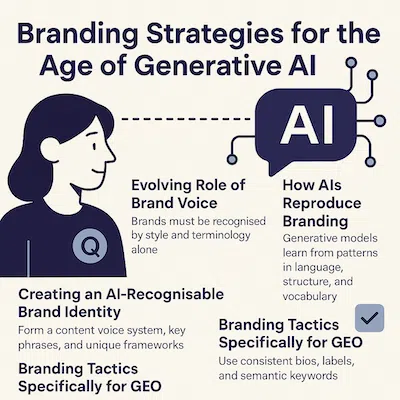Thursday, August 14, 2025 |
Brief Overview:
This article discusses how branding strategies must evolve for the era of generative AI. It explains how voice, consistency, and semantic branding elements influence whether and how AI engines represent your brand in conversational responses even when you’re not explicitly named.
Why Branding Needs to Evolve for Generative AI
Traditionally, branding revolved around visual identity, tone, and consistency across platforms. But with AI summarising and paraphrasing content in response to natural language prompts, brands now need to be recognisable in absence in tone, structure, and terminology.
In short: if an AI mentions your ideas without your name, will the reader still know it’s you?
That’s the challenge of branding in the AI era.
How Generative Engines Process and Reproduce Brand Traits
AI models like ChatGPT and Gemini don’t “see” brand colours or logos. They learn from patterns of language, structure, and vocabulary. Your brand becomes known to AI systems through:
-
Consistent phrasing and terminology
-
Repeated stylistic devices (e.g. metaphors, taglines, sentence rhythm)
-
Subject-matter depth in key topic areas
-
Structured content formats (how-tos, case studies, explainer blocks)
These patterns influence how your content is paraphrased and echoed in AI answers, even when your name isn’t cited directly.
Creating an AI-Recognisable Brand Identity
To build a generative-friendly brand:
-
Develop a content voice system: Go beyond tone of voice guidelines, document sentence structure, phrase preferences, and metaphors that define your style.
-
Own key phrases: Repeat certain phrases and concepts consistently across blogs, videos, and socials. Over time, AI engines may associate them with your brand.
-
Establish brand-specific frameworks: Create models or methods that are unique to you like “The Qube Method” or “The 3V Rule of Content Creation.” These stand a better chance of being cited in full by AI.
-
Use strategic interlinking and structured content: Consistency across your site strengthens brand presence in the AI’s internal representation of your domain.
Hidden Gem Insight:
AI models tend to mimic sentence cadence not just vocabulary. That means if your brand uses a distinct rhythm (short-long-short sentence structures, or rhetorical triplets), that pattern can be echoed when AI paraphrases your ideas, subtly embedding your brand “sound” into responses.
Branding Tactics Specifically for GEO
-
Add consistent author bios and brand stories to articles and pages. These humanise your content for AI systems trained on human-authored material.
-
Label your frameworks or theories clearly and use them consistently (e.g., “Our Qube Framework”).
-
Publish across media (video, audio, text). AI engines benefit from multi-modal exposure when learning how your brand communicates.
-
Ensure semantic reinforcement. Use keywords and topic phrases alongside brand mentions in content headers and body text.
Final Thoughts
Branding is no longer just for humans, it’s for machines too. In the generative search era, brand recognition is often indirect, inferred through tone, vocabulary, and structure. A strong, generative-friendly brand identity doesn’t just help users remember you, it helps AI present you more authentically and favourably in its own words.
Now is the time to make your brand unmistakable, even when it’s paraphrased.
